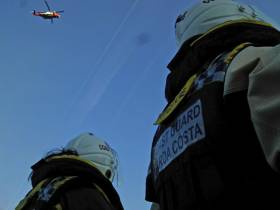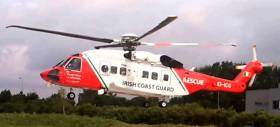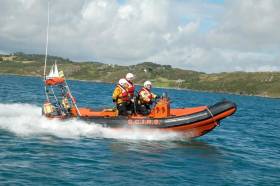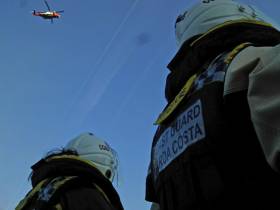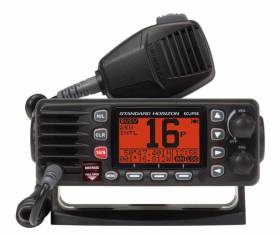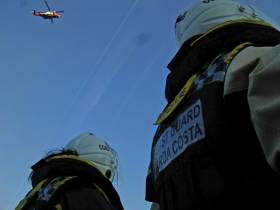Displaying items by tag: Coastguard
#Coastguard - The actions of a helicopter winchman during an incident in which a 14-year-old girl rescued from the sea fell back into the water have been found to be “sound” by an official investigation.
Aoife Winterlich died in hospital days after she and three other venture scouts were swept into the sea off Hook Head during an outing on 6 December 2015, as previously reported on Afloat.ie.
Two managed to swim to shore but Winterlich got in difficulty amid heavy seas, and the fourth youth, a 15-year-old boy, remained to keep her afloat till the Waterford-based Irish Coast Guard helicopter Rescue 117 arrived.
Severe conditions prompted the winchman to lift both teenagers from the water at the same time. As the three reached the helicopter, Winterlich slipped from her strop some 45 feet back into the water.
Records show that the winchman was back in the water to retrieve Winterlich just half a minute after reporting her fall, according to the Air Accident Investigation Unit Report as covered in The Irish Times.
Tragically, however, she died four days later at Our Lady’s Children’s Hospital in Crumlin.
“In the circumstances of this particular rescue, there is nothing to suggest that the winchman’s decision-making was anything other than sound,” the report said.
The Irish Times has more on the story HERE.
Sligo Coastguard In Medevac Of Russian Fisherman Off Mayo
#Rescue - The Sligo-based Irish Coast Guard helicopter completed an early-morning medevac of a crewman from a Russian fishing vessel off the Mayo coast yesterday (Wednesday 8 March).
Owing to the distance involved in the rescue effort, communication support — known as ‘top cover’ — was provided for Rescue 118 by a second coastguard helicopter, the Dublin-based Rescue 116.
Both helicopters refuelled at Blacksod prior to transiting to the scene, some 180 miles north west of Erris Head.
The Russian crewman, who required urgent medical attention, was airlifted at 4.30am and transferred to Sligo University Hospital, where he was admitted shortly before 6am.
The operation was co-ordinated by the Marine Rescue Sub Centre in Malin Head.
Schull’s Community Lifeboat To Join Irish Coast Guard
#Rescue - Schull’s independent community lifeboat will soon join the Irish Coast Guard, as the Southern Star reports.
Established in 2005, the Schull Community Inshore Rescue Service will be officially renamed as Schull Coast Guard later this month after two years of talks on assimilating the West Cork volunteer rescue service with the national SAR agency.
A reception is planned to mark the change, details of which will be announced on the SCIRS Facebook page.
The Southern Star has more on the story HERE.
New Coastguard Helicopter Hangar For Dublin Airport
#Coastguard - This month sees the start of construction of a new hangar at Dublin Airport for the Irish Coast Guard helicopter fleet, as Coast Monkey reports.
The new operations centre at the current base for Rescue 116 comes half-way into CHC Ireland’s 10-year contract to provide coastguard search and rescue services.
Works to be completed by the middle of next year will see the demolition of the existing 600 sqm hangar with a 2,000 sqm facility from where Ireland’s four SAR bases — at Dublin, Sligo, Shannon and Waterford — will be co-ordinated.
Coast Monkey has more on the story HERE.
Kayaker Dies After Lough Ree Incident
#LoughRee - RTÉ News reports that a man has died after an incident while kayaking on Lough Ree yesterday afternoon (Saturday 4 March).
Coastguard and RNLI teams recovered the casualty, believed to be an experienced water sportsman, after he went missing between Hodson Bay and the village of Lecarrow. He later died at Portiuncula Hospital in Ballinasloe.
Dog Rescued From Coastal Cliff Face In West Cork
#Coastguard - Goleen Coast Guard raced to the rescue of a dog trapped on a coastal cliff face in West Cork yesterday morning (Wednesday 22 February).
As BreakingNews.ie reports, two coastguard climbers set up a rig to abseil down to the border collie, named Boo, who had slipped down the cliff at Castlepoint near Schull.
“All went according too plan and boo was safely brought back to her owners again,” said a Goleen Coast Guard spokesperson.
Coast Guard Helicopters Conducting Long Medical Evacuation Assisted by Naval Ship LÉ Roisin
The Shannon based Coast Guard helicopter Rescue 115 has evacuated a seriously injured crewman from a large Russian fishing vessel approximately 140 nautical miles West of Kerry Head.
The operation is being coordinated by the Marine Rescue Coordination Centre in Valentia and is being supported by the Naval ship LÉ Róisín. Crew members from the LÉ Róisín went on board the vessel and assisted with casualty evacuation. Communication support and back up, known as Top Cover was provided by a second Coast Guard helicopter, the Waterford based R117.
Weather conditions in the area for helicopter operations were difficult, bordering on marginal for such operations with a strong West South West swell and winds gusting in excess of 35mph.
The helicopter is currently routing to University Hospital Limerick, to arrive before 7:30pm, following an essential fuel stopover at Kerry airport.
This is the second operation in recent weeks where the LÉ Róisín assisted the Coast Guard in an operation at sea. Coast Guard helicopters are capable of operating out to 200 miles and operations of this nature are indicative of the professionalism of the Coast Guard Helicopter Rescue crews. The Coast Guard complimented the crew of the LÉ Róisín for their efficiency in operating a RIB (Rigid Inflatable Boat) in difficult conditions and for getting crewmembers onto the fishing vessel.
LÉ Roisin responded to a request to provide medical assistance and recover an injured fisherman approx 200 nautical miles off Loop Head. pic.twitter.com/AFmnT3Vl5G
— Irish Defence Forces (@defenceforces) February 21, 2017
Waves Break Over Howth Pier in Easterly Gale (Coastguard Photos)
The Irish Coast Guard operations centre in Dublin received calls of people in danger of getting washed off the pier, a unit from Howth responded and assisted people back to safety.

UK Coast Guard VHF Channel Changes Coming in 2017
Boat owners, shipping companies and anyone who puts out to sea are being informed about a change in some of the VHF channel numbers used to contact UK Coastguard.
As a result of changes to Appendix 18 (Marine VHF) of the Radio Regulations it will mean that VHF channels 23, 84 and 86 will no longer be used for either Maritime Safety Information (MSI) or Radio Medical Advice.
The channels to use from September 2017 will be VHF 62, 63 and 64. The use of VHF Channel 10 for MSI and pollution control (back up) is unchanged.
Mark Lawson from the Maritime & Coastguard Agency said: 'Although it’s not happening until September, when it happens the changeover will be absolute and we want to make people aware of this changeover in good time given our commitment to deliver maritime safety and wider support to the maritime community.
'The exact date of change will be announced as soon as possible. In the meantime, we suggest anyone who uses any type of vessel makes a careful note of these replacement channels so they are ready when it does happen.'
Woman Airlifted To Hospital After Injury At Lough Gur
#Rescue - Shannon’s Irish Coast Guard rescue helicopter airlifted an injured woman to hospital from the shores of Lough Gur yesterday evening (Saturday 4 February).
As BreakingNews.ie reports, the woman had been walking with family next to the Co Limerick lake when she sustained a leg injury in a fall on uneven ground.


























